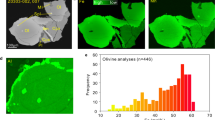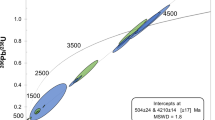Abstract
Samples of material returned from the Moon have established that widespread lunar volcanism ceased about 3.2 Gyr ago. Crater statistics and degradation models indicate that last-gasp eruptions of thin basalt flows continued until less than 1.0 Gyr ago1, but the Moon is now considered to be unaffected by internal processes today, other than weak tidally driven moonquakes2 and young fault systems3. It is therefore widely assumed that only impact craters have reshaped the lunar landscape over the past billion years. Here we report that patches of the lunar regolith in the Ina structure2,3,4,5 were recently removed. The preservation state of relief, the number of superimposed small craters, and the ‘freshness’ (spectral maturity) of the regolith together indicate that features within this structure must be as young as 10 Myr, and perhaps are still forming today. We propose that these features result from recent, episodic out-gassing from deep within the Moon. Such out-gassing probably contributed to the radiogenic gases detected during past lunar missions. Future monitoring (including Earth-based observations) should reveal the composition of the gas, yielding important clues to volatiles archived at great depth over the past 4–4.5 Gyr.
This is a preview of subscription content, access via your institution
Access options
Subscribe to this journal
Receive 51 print issues and online access
$199.00 per year
only $3.90 per issue
Buy this article
- Purchase on Springer Link
- Instant access to full article PDF
Prices may be subject to local taxes which are calculated during checkout




Similar content being viewed by others
References
Schultz, P. H. & Spudis, P. D. The beginning and end of lunar volcanism. Nature 302, 233–236 (1983)
Nakamura, Y. D. et al. New seismic data on the state of the deep lunar interior. Science 181, 49–51 (1973)
Schultz, P. H. Moon Morphology (Univ. Texas Press, Austin, 1976)
Whitaker, E. A. in Apollo 15 Preliminary Science Report 25-84–25-85 (NASA SP-289, US Government Printing Office, Washington DC, 1972)
El Baz, F. & Worden, A. W. in Apollo 15 Preliminary Science Report 25-1–25-25 (NASA SP-289, US Government Printing Office, Washington DC, 1972)
El-Baz, F. in Apollo 17 Preliminary Science Report 30-13–30-17 (NASA SP-330, US Government Printing Office, Washington DC, 1973)
Strain, P. & El Baz, F. The geology and morphology of Ina. Proc. Lunar Planet. Sci. Conf. XI, 2437–2446 (1980)
Schultz, P. H. in Workshop on Mare Volcanism and Basalt Petrogenesis (eds Taylor, L. A. & Longhi, J.) 37–38 (LPI Technical Report 91-03, Lunar and Planetary Institute, Houston, 1991)
Schultz, P. H., Staid, M. & Pieters, C. M. Recent lunar activity: evidence and implications. Lunar Planet. Sci. Conf. XXXI, 1919 (2000)
Wilhelms, D. E. & McCauley, J. F. Geologic map of the near side of the Moon. US Geol. Surv. Misc. Inv. Map I-703, (1971)
Soderblom, L. A. A model for small-impact erosion applied to the lunar surface. J. Geophys. Res. 75, 2655–2661 (1970)
Schultz, P. H., Greeley R. & Gault D. E. Degradation of small mare surface features. Proc. Lunar Sci. Conf. VII, 985–1003 (1976)
Wilhelms, D. E. The geologic history of the Moon. US Geol. Surv. Prof. Pap. 1348, (1987)
Masursky, H. G., Colton, G. W. & El Baz, F. Apollo over the Moon (NASA SP-362, US Government Printing Office, Washington DC, 1978)
Schultz, P. H., Greeley, R. & Gault, D. E. Interpreting statistics of small lunar craters. Proc. Lunar Sci. Conf. VIII, 3539–3564 (1977)
Nozette, S. et al. The Clementine Mission to the Moon. Science 266, 1835–1862 (1994)
Pieters, C. M., Staid, M. I., Fischer, E. M., Tompkins, S. & He, G. A. Sharper view of impact craters from Clementine data. Science 266, 1844–1848 (1994)
Lucey, P. G. et al. Abundance and distribution of iron on the Moon. Science 268, 1150–1153 (1995)
Fischer, E. M. & Pieters, C. M. Composition and exposure age of the Apollo 16 Cayley and Descartes regions from Clementine data: Normalizing the optical effects of space weathering. J. Geophys. Res. 101, (E1)2225–2234 (1996)
Blewett, D. T., Lucey, P. G. & Hawke, B. R. Clementine images of the lunar sample-return stations: Refinement of FeO and TiO2 mapping techniques. J. Geophys. Res. 102, 16319–16325 (1997)
Lucey, P. G., Blewett, D. T. & Hawke, B. R. Mapping the FeO and TiO2 content of the lunar surface with multispectral imagery. J. Geophys. Res. 103, (E2)3679–3699 (1998)
Staid, M. I. & Pieters, C. M. Integrated spectral analysis of mare craters and soils: Application to eastern nearside basalts. Icarus 145, 122–139 (2000)
Lucey, P. G., Blewett, D. T., Taylor, G. J. & Hawke, B. R. Imaging of lunar surface maturity. J. Geophys. Res. 105, 20377–20386 (2000)
Le Mouelic, S. et al. Discrimination between maturity and composition of lunar soils from integrated Clementine UV-visible/near-infrared data: Application to the Aristarchus Plateau. J. Geophys. Res. 105, (E4)9445–9455 (2000)
Shkuratov, Y. G. et al. Composition of the lunar surface as will be seen from SMART-1: A simulation using Clementine data. J. Geophys. Res. 108 (E4)5020 doi: 10.1029/2002JE001971 (2003)
Staid, M. I. & Pieters, C. M. Mineralogy of the last lunar basalts: Results from Clementine. J. Geophys. Res. 106, (E11)27887–27900 (2001)
Blewett, D. T., Hawke, B. R. & Lucey, P. G. Lunar optical maturity investigations: A possible recent impact crater and a magnetic anomaly. J. Geophys. Res. 110 E04015 doi: 10.1029/2004JE002380 (2005)
Hodges, R. R. & Hoffman, J. H. Implications of atmospheric 40Ar escape on the interior structure of the Moon. Proc. Lunar Sci. Conf. VI, 33039–3047 (1975)
Lawson, S. L. et al. Recent outgassing from the lunar surface: The Lunar Prospector Alpha Particle Spectrometer. J. Geophys. Res. 110 E09009 doi: 10.1029/2005JE002433 (2005)
Acknowledgements
We acknowledge S. Posin for his assistance in performing some of the crater statistics. Author Contributions P.H.S. made the observations, acquired relevant supporting data, and led the writing of the paper; M.I.S. performed the spectral analysis; M.I.S. and C.M.P. contributed to the writing of the paper.
Author information
Authors and Affiliations
Corresponding author
Ethics declarations
Competing interests
Reprints and permissions information is available at www.nature.com/reprints. The authors declare no competing financial interests.
Rights and permissions
About this article
Cite this article
Schultz, P., Staid, M. & Pieters, C. Lunar activity from recent gas release. Nature 444, 184–186 (2006). https://doi.org/10.1038/nature05303
Received:
Accepted:
Issue Date:
DOI: https://doi.org/10.1038/nature05303
This article is cited by
-
Dark spots on Mercury show no signs of weathering during 30 Earth months
Communications Earth & Environment (2022)
-
Active moon: evidences from Chandrayaan-1 and the proposed Indian missions
Geoscience Letters (2014)
Comments
By submitting a comment you agree to abide by our Terms and Community Guidelines. If you find something abusive or that does not comply with our terms or guidelines please flag it as inappropriate.



